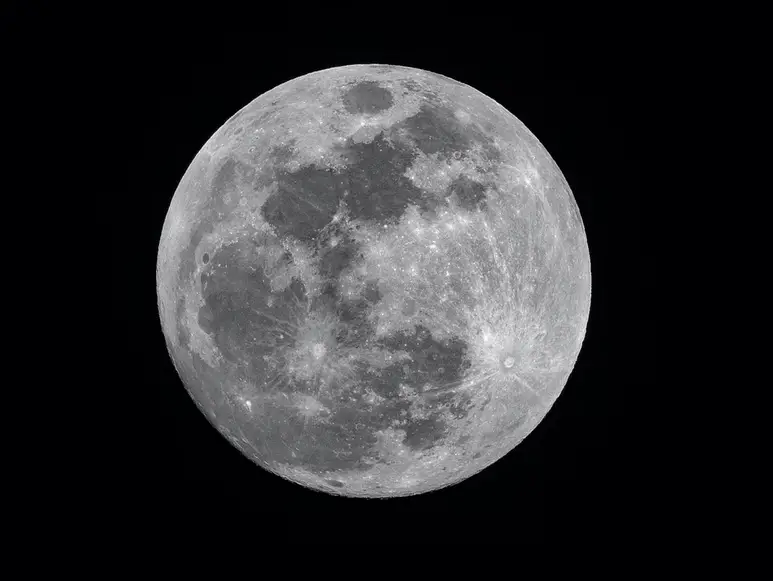
Remember when we were kids and we drew images of the night sky? Remember how we used to draw many small stars, a big yellow Sun with spikes, and a big white Moon?
And then, we grew up. And we realized that the Moon isn’t white. It is gray and sometimes seems to change color into a few more shades.
Read on to find out the different colors of the Moon and what is truly the color of our Moon. Is it gray and devoid of all colors? Or is it a mixture of various colors out of which gray is visible to the naked eye?
Why Is The Moon Gray?
Let’s begin with the basics. Why is the Moon gray? It is because there are various minerals on the Moon’s surface that make it reflect different colors. These minerals include:
- Calcium
- Magnesium
- Pyroxene
- Iron
- Silicon
- Feldspar
- Hydrogen
- Titanium
And other silicate minerals that are predominantly gray in their dust form. The Moon does not emit its light and merely reflects the light coming from the Sun.
The Moon seems to change color sometimes as it has faced a constant bombardment of meteorites in the past. It has faced scars owing to its formation which was fast and violent.
This is why we can spot dark patches on the Moon’s surface even with our naked eyes on the Earth. Now we know why the Moon is gray. But why does it seem to change color at times and what do each of these colors mean?
What Factors Influence The Moon’s Colors?
There are many aspects to be kept in mind while studying the different colors of the Moon. The primary factor is where the observer is located.
If you are located in a highly polluted city, you will most likely witness a different shade of the Moon. This is owing to the dust particles and other objects floating in your environment.
The location also impacts the details you can observe on the Moon. Are you equipped with a powerful telescope and are you located close enough? Also, keep in mind the positions of the Sun and the Moon.
The colors of the Moon you can observe will change if the Sun is high on the horizon or low. It also depends on how clear your vision is and how well you can see and interpret colors. If you can see blue as green, you might mistake the actual color of the Moon to be something else!
Which Colors Can We Predominantly See?
A recent study investigated the result of various forms of light applied on the surface of the Moon to observe the colors and changes. The most common colors we can observe include red, blue, and orange.
The red Moon is sometimes called the Blood Moon, which is observed in the night sky very rarely. This is observed when the Moon takes on a rusty color while entering a lunar eclipse.

Let’s slow down a bit and see the reasons behind why these colors occur.
What Makes The Moon Look Red?
As mentioned, the Moon enters a total eclipse during the lunar eclipse. When viewed from the Earth, it will look red instead of black. This is due to the presence of residual sunlight that is scattered towards it from our Earth’s atmosphere.
As we have discussed, the Moon doesn’t have any color of its own. It reflects light and colors from the Sun. When the Earth’s atmosphere scatters residual light towards it, we can witness a Blood Moon.
Why Does The Moon Look Orange?
We will keep this simple. Imagine how much of the Earth’s atmosphere a celestial body will have to pass through if it is low on the horizon. The light would have to travel a lot more distance and cross various gases and particles before reaching our eyes.
Hence, it is understood that if the Moon is orange, it must be due to its low position on the horizon. This makes the light cross various layers of gases and pollution that give it a yellow or orange glow.
Why Is The Moon Blue?
Ever heard the proverb ‘once in a Blue Moon’? Well, the reason behind this is due to how rare this phenomenon occurs. Can you fathom how much dust and smoke must be present in the air for the Moon to appear to change color?
It’s a safe bet to say a lot! An enormous amount of dust present in the air makes the Moon appear blue in the night sky. This phenomenon could also occur due to volcanic eruptions or during the aftermath of a wild forest fire.
Frequently Asked Questions
How Do We Calculate The Reflectivity On A Planet’s Surface?
We measure the reflectivity of a surface in albedo units. If the albedo percentage is 0%, no light is reflected and the object is black. If it is close to 80%, the object reflects a significant amount of light and is considered white. If it reaches 100% albedo, then it reflects all the light received.
What Is The Actual Color Of The Moon?
Scientists have concluded that the Moon is almost black. This is based on various levels of research and experimentation which they have conducted. The Moon reflects barely 8% albedo, which makes it black or gray.
What Does It Mean If I Spot A Red Moon In The Sky?
It means that you are witnessing a total lunar eclipse and the Moon you are seeing is a Blood Moon. It means that a lot of residual sunlight is getting scattered towards the Moon from the Earth’s atmosphere.
Summing Up
When we begin exploring the different colors of the Moon, the colors may the limited, but the reasons behind them are numerous! Depending upon a person’s location, the position of the Sun with the Moon, and several other factors, the colors of the Moon change.
The Moon has no light and reflects the light from the Sun. Owing to a very low albedo measurement of barely 8%, scientists have concluded that the Moon is truly black and not white.

Now you know what’s happening the next time you spot a red, blue, or orange Moon in the sky. And be sure to use your word carefully the next time you accuse someone of calling you only ‘once in a Blue Moon’!
